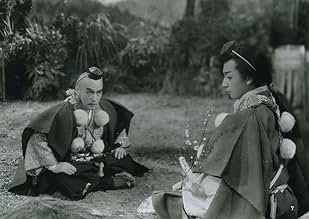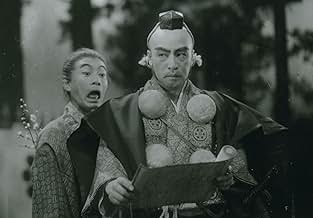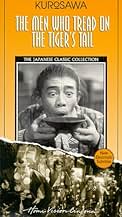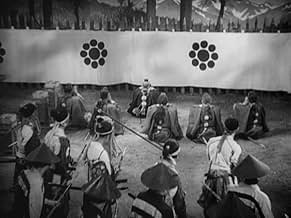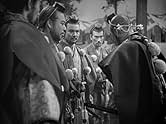Los hombres que caminan sobre la cola del tigre
Título original: Tora no o o fumu otoko-tachi
CALIFICACIÓN DE IMDb
6.7/10
4.7 k
TU CALIFICACIÓN
Japón medieval. Un samurai huye de su hermano. Tanto él como sus guardaespaldas tienen que disfrazarse de sacerdotes para atravesar un bosque y eludir a los guardias de la frontera.Japón medieval. Un samurai huye de su hermano. Tanto él como sus guardaespaldas tienen que disfrazarse de sacerdotes para atravesar un bosque y eludir a los guardias de la frontera.Japón medieval. Un samurai huye de su hermano. Tanto él como sus guardaespaldas tienen que disfrazarse de sacerdotes para atravesar un bosque y eludir a los guardias de la frontera.
- Dirección
- Guionistas
- Elenco
- Dirección
- Guionistas
- Todo el elenco y el equipo
- Producción, taquilla y más en IMDbPro
Opiniones destacadas
One can, for the first time, in my opinion, see what Kurosawa could do. He follow a group. of men trying to get through a checkpoint, disguised as priests. Their leader is disguised as a porter and therefore must dishonored to be protected. This is all part of a legend in ancient China and the audiences pretty much knew the story. Kurosawa provides comic relief with the true porter who is an unforgettable character. He is one of those pests that drives one crazy, yet he is so persistent in his efforts to be included. Apparently, historically, things don't bode well for the future but the standoff that occurs as they pretty much risk their lives to get through is quite breathtaking. There are incredible images of the landscape and the use of closeups is vibrant and sharp. The porter's dance at the end is terrific, against a bank of clouds, silhouetted against the sky.
The film is not only based on an incident that happened in the 12th century, but also on the Noh play Ataka, and on the Kabuki play Kanjincho. Initially banned, the film was first released in 1952 and is the fourth film made by Akira Kurosawa. The Men Who Tread On The Tiger's Tail focuses on the exemplification of true feudal values that ruled Japan starting in the Heian period. In order to understand the movie perfectly, one has to know what happened before the events depicted in the picture. Here's a brief presentation of the story: after winning a bloody Naval battle with the rival Heike clan, the triumphant lord Yoshitsune Minamoto returns to Kyoto in order to take command. However, his jealous and envious brother Shogun Yoritomo orders his men to arrest Yoshitsune and all his comrades. Due to a lucky circumstance, Yoshitsune and six of his loyal samurai retainers are able to escape. In order to be truly safe they need to travel through the country and find shelter in the home of an only friend, Idehira Fukiwara.
The movie starts when a group of monks traverses through a huge forest. Being accompanied by a silly yet truly helpful porter (Kenichi Enomoto), the group rests and decides to figure out a perfect plan. It's the first time the audience gets acquainted with all the characters, in order to realize that the monks are actually the lord (Hanshirô Iwai) and his samurai companions in disguise. They plan to march to the gate where the keepers await, and trick them into believing that they're actually a group of friendly monks gathering money to build a large temple in Kyoto. Unfortunately, the gatekeepers are already aware that a group of seven men is traveling through the country in such a disguise. With the help of the porter the men finally arrive and face the enemy, in what seems to be a tranquil, yet strangely intense, battle of nerves. Benkei (Denjirō Ōkōchi), a warrior monk, and Yoshitsune's most loyal friend, takes the stand and tries to persuade the watchful sentries of their faked mission. After a few moments of danger, just when the whole situation seems to be in shambles, Benkei once again shows his unmistakable intelligence and self-control. He proves that his skills and experience are masterful, leading to a successful ending to this dramatic story.
The Men Who Tread On The Tiger's Tail is not Kurosawa's best, bust still a truly remarkable, detailed, and culturally conscious period drama, where the many ponderous Japanese virtues meet with an ostensibly stagnant atmosphere, all covered up in a package of truly minimalistic aspirations. Though short and not that interesting as many hope it would be, the film gives a fantastic glimpse at the rules that governed Japan in the 12th century, and presents a story, where wisdom and decisiveness are more valuable than bravery and prowess.
The movie starts when a group of monks traverses through a huge forest. Being accompanied by a silly yet truly helpful porter (Kenichi Enomoto), the group rests and decides to figure out a perfect plan. It's the first time the audience gets acquainted with all the characters, in order to realize that the monks are actually the lord (Hanshirô Iwai) and his samurai companions in disguise. They plan to march to the gate where the keepers await, and trick them into believing that they're actually a group of friendly monks gathering money to build a large temple in Kyoto. Unfortunately, the gatekeepers are already aware that a group of seven men is traveling through the country in such a disguise. With the help of the porter the men finally arrive and face the enemy, in what seems to be a tranquil, yet strangely intense, battle of nerves. Benkei (Denjirō Ōkōchi), a warrior monk, and Yoshitsune's most loyal friend, takes the stand and tries to persuade the watchful sentries of their faked mission. After a few moments of danger, just when the whole situation seems to be in shambles, Benkei once again shows his unmistakable intelligence and self-control. He proves that his skills and experience are masterful, leading to a successful ending to this dramatic story.
The Men Who Tread On The Tiger's Tail is not Kurosawa's best, bust still a truly remarkable, detailed, and culturally conscious period drama, where the many ponderous Japanese virtues meet with an ostensibly stagnant atmosphere, all covered up in a package of truly minimalistic aspirations. Though short and not that interesting as many hope it would be, the film gives a fantastic glimpse at the rules that governed Japan in the 12th century, and presents a story, where wisdom and decisiveness are more valuable than bravery and prowess.
So, seven outlawed noblemen are.... here we see the roots of THE SEVEN SAMURAI. Except that in an hour and writing by himself, Kurosawa winds up concentrating solely on one of them, Denjirô Ôkôchi.
Kurosawa would later note that he preferred to work with other writers, so that other characters could come to the fore. Anyway, they're trying to get past a barrier and to safety in a time of war. Sounds a bit like THE HIDDEN FORTRESS, doesn't it? According to my reading, all of Toho's actresses had been sent out of Tokyo because of bombing. Otherwise he might have made the other movie in 1945. There's surely a hint of it, when the noblemen they are trying to keep safe is said to look like a girl.
Kurosawa would later note that he preferred to work with other writers, so that other characters could come to the fore. Anyway, they're trying to get past a barrier and to safety in a time of war. Sounds a bit like THE HIDDEN FORTRESS, doesn't it? According to my reading, all of Toho's actresses had been sent out of Tokyo because of bombing. Otherwise he might have made the other movie in 1945. There's surely a hint of it, when the noblemen they are trying to keep safe is said to look like a girl.
I have watched this several times and enjoyed each viewing. It's a very early Kurosawa, apparently done on a shoestring of a budget. However, we can already see Kurosawa's talents in pacing and setting up shots. Kenichi Enomoto as the porter appears out of place at first with his over the top mannerisms and broad comedy, but he fits into the story and breaks up the slower pace of some of the scenes. For Kurosawa and samurai fans, I think this will be more than just a curiosity. This has an early appearance of Masayuki Mori (the murdered husband in Roshomon) and a fairly early appearance of Takashi Shimura (leader of the seven samurai). I recommend this for the usual suspects.
I chose to watch this on the way home from a trip where Japanese heritage was central. I have saved this early Kurosawa for such a special occasion, knowing that it would be heavily stylized. I thought that would detract from the effect; surely that is what most commentors say.
Cinematically, this has the essential Kurosawa: layered staging, profound cosmic forces testing human resources and strong character extremes.
The central character is disowned royalty, determined to set things right. We see little of him, and not even his face until things are nearly over.
I believe that it is Kurosawa's intention that he be the watcher and motivator both. As our on screen surrogate, this places us as both the watcher and the governing truths. It is a very clever reversal of the tradition, strong even then and even in Japan. The reversal is overt: he/we displace a comic porter, a simpleton that in a slightly less modern story would be the watcher.
He does watch, but as the thing evolves, he becomes more and more a featured act. Coming at the beginning of Kurosawa's career, it is tempting to think of this as paired with "Ran," the fool of the beginning to the King Lear of the end. This fool is not wise, but he is present in a way that no one else is, allowing us to carry the film.
The "film within" in this case is an impromptu prospectus for a rebuilt temple. I know of no more dramatically effective sequence than this, witnessed by an honorable man who takes the blessing seriously, and a foppish villain who creeps around during the speech. These are the fundamentals. As time would go, he could work with something better than a two-layered sound stage, and more complex narratives than this simple vignette. But I think the soul and sound of this is every bit as good as his best.
Ted's Evaluation -- 3 of 3: Worth watching.
Cinematically, this has the essential Kurosawa: layered staging, profound cosmic forces testing human resources and strong character extremes.
The central character is disowned royalty, determined to set things right. We see little of him, and not even his face until things are nearly over.
I believe that it is Kurosawa's intention that he be the watcher and motivator both. As our on screen surrogate, this places us as both the watcher and the governing truths. It is a very clever reversal of the tradition, strong even then and even in Japan. The reversal is overt: he/we displace a comic porter, a simpleton that in a slightly less modern story would be the watcher.
He does watch, but as the thing evolves, he becomes more and more a featured act. Coming at the beginning of Kurosawa's career, it is tempting to think of this as paired with "Ran," the fool of the beginning to the King Lear of the end. This fool is not wise, but he is present in a way that no one else is, allowing us to carry the film.
The "film within" in this case is an impromptu prospectus for a rebuilt temple. I know of no more dramatically effective sequence than this, witnessed by an honorable man who takes the blessing seriously, and a foppish villain who creeps around during the speech. These are the fundamentals. As time would go, he could work with something better than a two-layered sound stage, and more complex narratives than this simple vignette. But I think the soul and sound of this is every bit as good as his best.
Ted's Evaluation -- 3 of 3: Worth watching.
¿Sabías que…?
- TriviaProduction had to be halted briefly during production of the film as Japan surrendered, bringing an end to the hostilities of World War II. Akira Kurosawa recollected breaking during production to listen to the address by Emperor Hirohito on August 15th, 1945.
- ConexionesFeatured in Great Performances: Kurosawa (2000)
Selecciones populares
Inicia sesión para calificar y agrega a la lista de videos para obtener recomendaciones personalizadas
- How long is The Men Who Tread on the Tiger's Tail?Con tecnología de Alexa
Detalles
- Fecha de lanzamiento
- País de origen
- Idioma
- También se conoce como
- The Men Who Tread on the Tiger's Tail
- Locaciones de filmación
- Toho Studios, Tokio, Japón(Studio)
- Productora
- Ver más créditos de la compañía en IMDbPro
- Tiempo de ejecución
- 59min
- Color
- Mezcla de sonido
- Relación de aspecto
- 1.37 : 1
Contribuir a esta página
Sugiere una edición o agrega el contenido que falta

